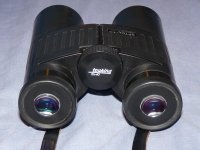Henry, I just don't know which means I'm subject to me speculation. Lawd help us all.
The body has the P inside the silver square, yet it isn't up front on the round knob. It has to mean the same regardless of where it is even if it wasn't, as mine, at both spots. I think that later models were also adorned on the round knob as some type of bling that the user would notice bringing the glass to bear.
If indeed the P stands for Phase, and what else would it taking into consideration the known time frame 2000-2006, then how could the bin be half phased or the others that included the knob as well double phased?
The only thing that might elude to a non phase would be an earlier date. I've never seen this article in Outdoor Life about the optic review in 2000. Outdoor Life has their archives available for around eight bucks for thirty days. Perhaps in the article they might mention if the 10x45 was a new offering of Optolyth.
But, why not chose one of the more traditional Optolyth bins w/objective in 56/63? Outdoor life isn't a birding mag. Nor would I speculate that any ad money would come from Optolyth. Perhaps the competition would be a mite tight. Here's what I found posted ten years ago.
"In the Outdoor Life 2000 gear test they tested a Optolyth 10x45 Royal BGA and some of the other binoculars tested where Zeiss 15x60 B/GA,Steiner 8x56 Nighthunter, Bausch&Lomb 12x50 Elite[the porro with the offset going verticle instead of horizontal,Pentax 16x60 PCF V,and the Editor's Choice of the Swarovski 8.5x42 EL [the older slow focus model or original].Testing these they do use 1951 USAF resolving charts and also use and aux. 3X scope for magnified resolution.They do check the binoculars out pretty good.
The binoculars could score from 1 the lowest to 5 the highest and on some they would list the measured arc seconds.The Swarovski got a 5 with 3.3 arc seconds, Bausch&Lomb 12x50 a 5,the Zeiss 15x60 B/GA a 5.The next rung down was the Pentax 16x60 PCF V with a 4,the Optolyth 10x45 Royal with a 4 and the last out of this bunch was the Steiner 8x56 Nighthunter with a 3.5.
In this same article they test some spotting scopes.Bausch&Lomb Elite 20-60x80mm ED,Nikon Fieldscope III ED 20x45x60mm,Pentax PF-80 with 36x eyepiece all these rated a 5 and they also tested a Optolyth 30x80mm B/GA spotter and it rated 4.5 for resolution.They did pick the Nikon Fieldscope III ED as their Editor's Choice."
W/o the entire article we we are left reading betwixt the lines.
Apparently, given limited information, the 10x45 was not in production long as little can be dredged up on it or the 8x45. If the 10x45 started production in the pre-phased era surely it would pop up in a catalogue that should date back at least to the late 1980's.
I like the 10x45, but then I like a lot of old glass. They are a bit long and heavy. The focus wheel turns within an eighth of three turns. With the rest of the line entrenched as hunting bins w/considerably larger objectives the 8/10x45 found themselves in odd company. Likewise they were only vaguely similar to other companies offerings in a 8/10x40/42 that were considerably lighter and more compact.
In the states Optolyth is the red headed step child and the 8/10x45 Royal was the RHSC of the RHSC. Its a shame because this bin cries out to be a 14X. And 14x45 would not be a night/late evening/early morn bin either.
But, the length/weight/balance at 14X would be quite the daytime glass at what I consider to be the best highest hand held power. A forty-eight-fifty mm objective would be better, but I still peer through the old Nixon 12x36 pre-phase roofs on occasion. Finding plenty of contrast and resolution even if the colour doesn't pop.
ETA: The "test" any by OL should be taken w/grain of salt. In this OL midsize test they include the Sig Sauer Zulu 3 10x32.
http://www.outdoorlife.com/features/gun-and-optics-test/binoculars
"It turned in good resolution scores—probably because of its 10X configuration—but then bombed the low-light test, and our panel noted generally poor image rendition and significant edge distortion."
Imagine that, the only 10x32 compared against 8x32s. Are we to believe that the vaunted 1951 Air Force resolution test was performed at the same length w/Zulu three as the 8x32s? As well, why am I not surprised that a 3.2 EP "bombed" against others sporting 4 EP? No mention of why the Zulu 3 in 8x32 was not used.
The editors choice in full size is the Leica Ultravid HD Plus 10x42.
"the Leica dominated our resolution test, scoring a perfect 10"
OK, where's the disclaimer on
their 10X?
To no surprise nary a word about low light performance.
They were too busy drooling to concern themselves w/such subjectivity whilst mingling w/royalty. o










